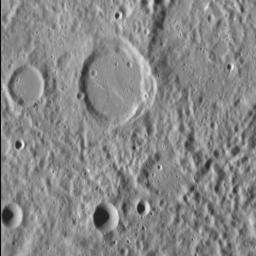
|
Older Smooth Plains on Mercury
- Click the image above for a larger view
- Full-Res JPEG (1024 x 1024) (109.9 kB)
- Full-Res TIFF (1024 x 1024) (1.1 MB)
Caption:
There is abundant evidence that smooth-floored impact basins have been filled with lava . But less clear is the nature of more heavily cratered terrain surrounding smooth-floored basins and craters, such as that seen in this image. This hilly, rough terrain may have resulted from the piling up of ejecta from nearby craters. But looking more closely, there are several older, less well-preserved craters that also have smooth floors -- implying that they too were filled with lava after they formed. Similar observations elsewhere on Mercury suggest that many older portions of the planet's surface were originally smooth volcanic plains, before subsequent impacts rendered them hilly and rough.
This image was acquired as a high-resolution targeted observation. Targeted observations are images of a small area on Mercury's surface at resolutions much higher than the 250-meter/pixel (820 feet/pixel) morphology base map or the 1-kilometer/pixel (0.6 miles/pixel) color base map. It is not possible to cover all of Mercury's surface at this high resolution during MESSENGER's one-year mission, but several areas of high scientific interest are generally imaged in this mode each week.
Date acquired:
October 12, 2012
Image Mission Elapsed Time (MET):
258546552
Image ID:
2752143
Instrument:
Narrow Angle Camera (NAC) of the Mercury Dual Imaging System (MDIS)
Center Latitude:
-21.0°
Center Longitude:
320.8° E
Resolution:
88 meters/pixel
Scale:
The smooth-floored crater at center is 32 km (20 mi.) in diameter.
Incidence Angle:
67.6°
Emission Angle:
32.6°
Phase Angle:
100.2°
Background Info:
The MESSENGER spacecraft is the first ever to orbit the planet Mercury, and the spacecraft's seven scientific instruments and radio science investigation are unraveling the history and evolution of the Solar System's innermost planet. Visit the Why Mercury? section of this website to learn more about the key science questions that the MESSENGER mission is addressing. During the one-year primary mission, MDIS acquired 88,746 images and extensive other data sets. MESSENGER is now in a year-long extended mission, during which plans call for the acquisition of more than 80,000 additional images to support MESSENGER's science goals.
For information regarding the use of images, see the MESSENGER image use policy .
Cataloging Keywords:
| Name | Value | Additional Values |
|---|---|---|
| Target | Mercury | |
| System | ||
| Target Type | Planet | |
| Mission | MESSENGER | |
| Instrument Host | MESSENGER | |
| Host Type | Orbiter | |
| Instrument | Mercury Dual Imaging System (MDIS) | |
| Detector | Narrow Angle Camera (NAC) | |
| Extra Keywords | Crater, Grayscale, Impact, Map, Radio, Volcano | |
| Acquisition Date | ||
| Release Date | 2012-12-05 | |
| Date in Caption | 2012-10-12 | |
| Image Credit | NASA/Johns Hopkins University Applied Physics Laboratory/Carnegie Institution of Washington | |
| Source | photojournal.jpl.nasa.gov/catalog/PIA16532 | |
| Identifier | PIA16532 | |
